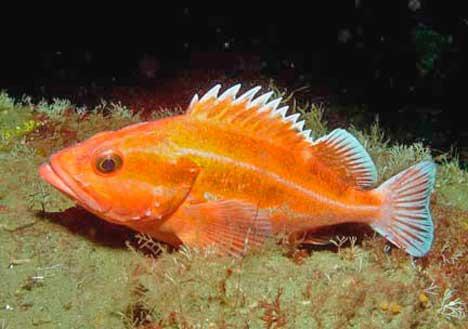The number of marine creatures threatened by extinction in Puget Sound is growing.
The federal agency in charge of fishery management, the National Oceanic and Atmospheric Administration, on Tuesday announced that three types of rockfish in Washington state’s Georgia Basin will be protected under the Endangered Species Act.
Two species of rockfish — canary and yelloweye — have been designated as “threatened” by NOAA and a third — bocaccio — is considered “endangered”. Under the ESA, an endangered species is at high risk of extinction; a threatened species is vulnerable to extinction in the near future and in need of protection
Populations of all three rockfish species in the Georgia Basin, which encompasses Puget Sound and the Strait of Georgia, were historically harvested at high levels and their numbers were depleted as a result, according to a NOAA press release. Rockfish are long-lived and mature slowly, with only sporadic episodes of successful reproduction, making them especially vulnerable to overfishing, according to the agency.
According to NOAA scientists, rockfish population growth has also been hampered because they are often caught unintentionally by fishermen targeting other species, and by environmental factors, such as degradation of their near-shore habitat, pollution and abandoned fishing gear that continues to snare fish.
The listing becomes effective July 27.
Although rockfish make up a substantial portion of the federally-managed commercial bottomfish catch off the West Coast, especially off California, rockfish in Puget Sound are managed by the state. New rules enacted early this year by the Washington Fish and Wildlife Commission prohibit fisherman keeping any rockfish that are caught accidentally and from angling for bottomfish at a depth greater than 120 feet, where most adult rockfish are found. The new rules take effect May 1.
Yelloweye, canary and boccacio rockfish join a growing list of marine creatures in Puget Sound that are protected by federal law. The Southern resident killer whales, Chinook salmon, chum salmon, steelhead and bull trout are listed as “threatened” and already protected by the ESA.
There is currently a broad state and federal effort to improve the sound’s water quality and habitat through the Puget Sound Partnership, which is aimed at conserving all marine life, including rockfish.
Tuesday’s listing is in response to a petition from an Olympia resident who in 2008 asked the agency to list five species of Puget Sound rockfish. In addition to bocaccio, canary and yelloweye, the petition included greenstriped and redstriped rockfish. Agency scientists determined the other two are at a “low risk” of extinction and protection under the ESA is not needed at this time.
NOAA held a 60-day public comment period on the listings, from April 23 to June 22, 2009, and received a total of five comment letters on the listing proposals from local and state government, the public, and from others familiar with rockfish biology and management.
For more information on the rockfish ESA listing, visit, http://www.nwr.noaa.gov/Other-Marine-Species/Puget-Sound-Marine-Fishes/ESA-PS-Rockfish.cfm



